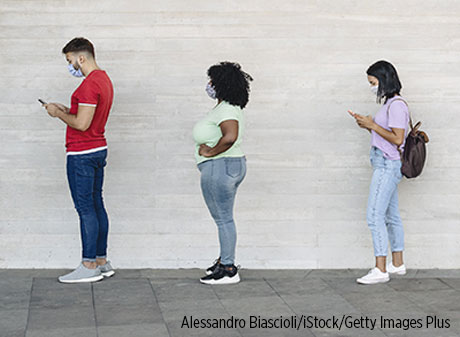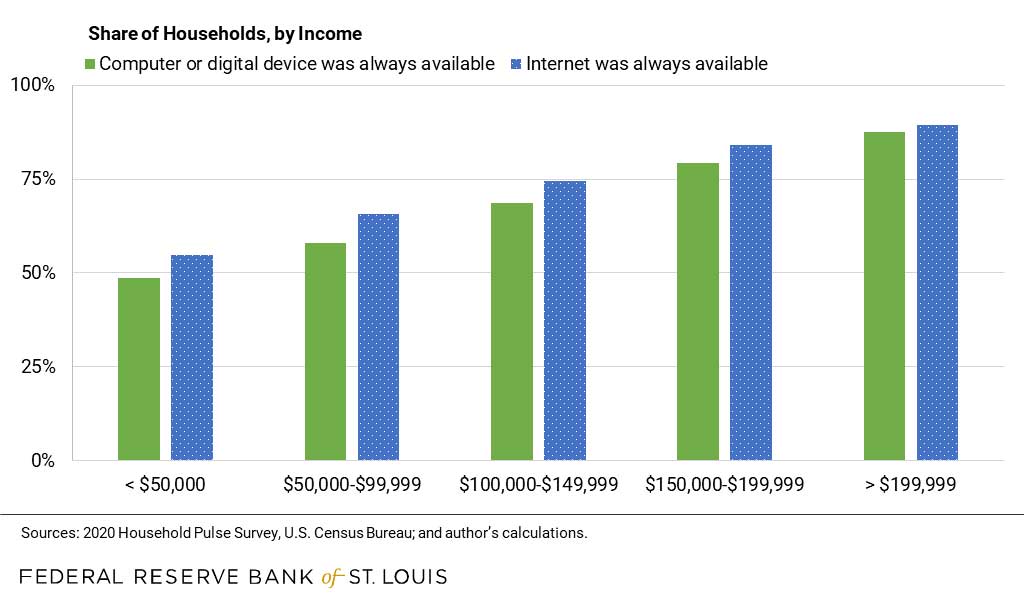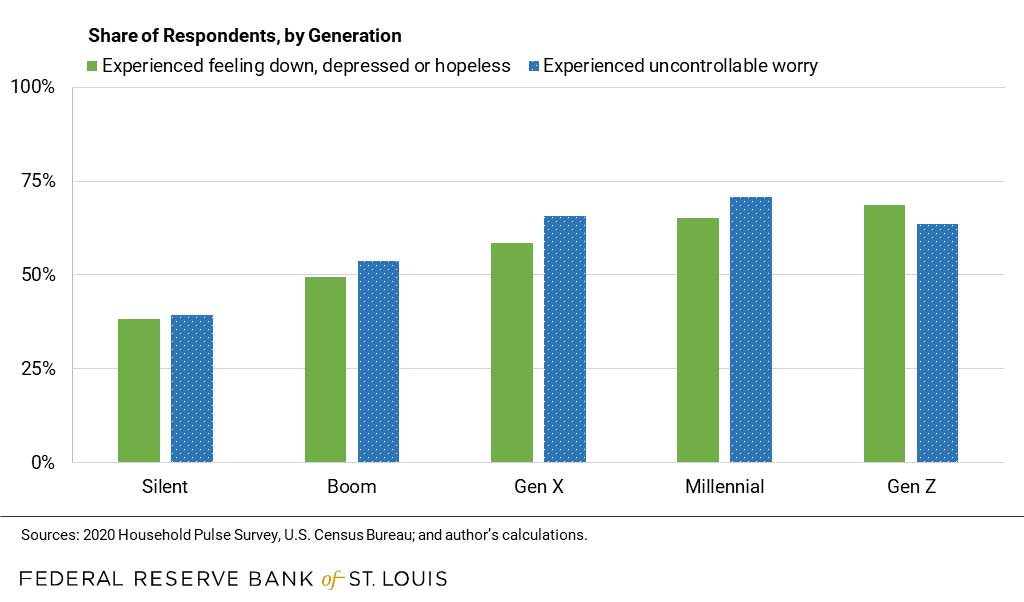COVID-19 Pressures Could Reverberate in Gen Z Futures

A quick survey of my siblings this summer revealed some of the challenges that COVID-19 presents to Generation Z.
My youngest brother, who is 13, worried that he would feel lonely and bored during his online classes this fall. My middle brother, 16, normally attends a high school special needs program, with one-on-one interaction which will be impossible to fulfill virtually. At 23, my eldest brother was able to avoid the rapid, indiscriminate spread of the pandemic in his home state of New York this past spring by temporarily staying with family members.
As for me, I’m 21 and completed a remote internship with the St. Louis Fed from my parents’ home in St. Louis before I entered my senior year of college at The Ohio State University. Classes at the university are being offered in formats including in-person, online and combinations of the two.
My family members are among the lucky ones. Not everyone can comfortably stay at home while isolating, or escape a precarious metropolitan lifestyle by working virtually. For those who can move back in with family, it is a lifestyle change that often comes with a host of its own challenges—in my case, the challenge has consisted of convincing my youngest brother that there’s more to life than playing Minecraft video games all day.
Members of Generation Z, or “zoomers,” who were born from 1997 to 2012, have already suffered significant adverse effects due to the pandemic. In addition to health threats, the vast majority of Gen Z is contending with educational disruption.
And different concerns stand out at opposite ends of the age spectrum. Younger zoomers are facing social upheaval during their formative years, while older zoomers may worry about future economic prospects, including job market uncertainty.
Young Zoomers Face Educational and Social Upheaval
The majority of primary, secondary, and higher education institutions transitioned at least part of their curriculum delivery to online learning, according to an Aug. 26 U.S. Census Bureau article and data from the Chronicle of Higher Education. However, the overall effectiveness of virtual learning will likely depend on factors like age and access to resources, according to a research article published in the February 2009 issue of Computers & Education.
According to the U.S. Census Bureau’s Household Pulse Survey, families with lower incomes are less likely to have consistent computer or internet access for their children’s education, as can be seen in the chart below.
Online Access in Spring Was Better for Higher-Income Households

NOTES: The data are from the survey conducted April 23 to May 5. Responses are broken down by total household income in 2019. Missing values are omitted from calculations.
DESCRIPTION: This chart shows how many households reported that a digital device (green bars on left in bar pairs) or internet access (blue patterned bars on right) was always available for children who were enrolled in public or private schools. About 50% of households where income was less than $50,000 reported consistent access to those resources, versus 79% and up for households with income of $150,000 or more.
A study by management consulting firm McKinsey & Company published June 1 showed that remote delivery for K-12 education has been much less effective than face-to-face schooling, with decreased participation across the board.
Such fluctuations in the early lives of younger zoomers—at a time when education is most crucial—can significantly hurt earnings and academic achievement later in life. These effects are exacerbated for students in low-income neighborhoods, according to a May 22 article by researchers at the Federal Reserve Bank of Richmond.
For primary and secondary school students, the benefits of attending school are not limited to instruction. School is an integral means of social and emotional development and can provide safety, nutrition and physical activity.
And as schools are often the primary mechanism through which students make friends and interact with people outside of their immediate family, transitioning to a virtual environment may cause them to lose out on these additional benefits.
Older Zoomers Are Losing Jobs and Opportunities
Like many millennials before us, older members of Gen Z are experiencing a recession just as we are preparing to step out into the workforce.
Members of Gen Z who are either in the workforce or looking to enter it are facing a strained job market. At its peak this April, the unemployment rate for Gen Z had more than doubled from the same time last year, according to data from the Current Population Survey.
In July, the unemployment rate for Gen Z members above age 16 was 18.9%, compared with the national rate of 10.5%. Those numbers were 10.1% and 4.0% in July 2019 (not seasonally adjusted), respectively. Unemployment within Gen Z’s minority groups were exceptionally high, according to a June release of the Current Population Survey—20.9% for Hispanic people and 27.7% for Black people, versus 15.3% for white people.
Moreover, rather than seeing an increase in their labor force participation rate during the summer months, COVID-19 restrictions significantly reduced the number of zoomers who were looking for jobs or in the workforce. In responses to the Household Pulse Survey conducted from July 16 to July 21, a majority of adult zoomers reported they were not working during the prior seven days due to COVID-19 issues. (See table.)
| Business slowed or closed or respondent was laid off due to COVID-19 | 41.3% |
|---|---|
| Didn't want to be employed | 18.4% |
| Concerned about COVID-19 | 13.1% |
| Caring for children, elderly or someone with COVID-19 symptoms | 5.2% |
| Sick with COVID-19 symptoms | 4.5% |
| Other | 17.4% |
| SOURCES: U.S. Census Bureau, 2020 Household Pulse Survey, responses to question about the week prior to July 16-21, and author’s calculations. | |
Anxiety and Educational Uncertainty Take a Toll
The impacts of COVID-19 on Gen Z don’t end with losing job opportunities.
I’ve heard from many of my college-aged peers about their concerns. They have said they felt they are falling behind since the pandemic interrupted their spring semester. Pandemic-related restrictions kept some of them from adding value to their resumes and gaining income—hurting both their professional development and financial security.
Furthermore, the continuation of distance learning will restrict our abilities to connect with professors and peers, network and participate in extracurricular activities—all important markers of a college experience. These issues have led many of my peers to question the value of their studies and whether their education is worth the tuition.
These uncertainties all feed into a general sense of fear and anxiety for students, whether over immediate educational concerns or how these lost opportunities may translate long term.
The Household Pulse Survey shows that the majority of Gen X, millennial and Gen Z respondents (age 18 or older) reported experiencing some form of uncontrollable worry, depression or hopelessness since the survey began at the end of April. Gen Z reported experiencing the poorest mental health compared with other generations over the seven days prior to the survey conducted between April 23 and May 5, with about 60% reporting feeling worried or down. Millennials’ concerns were more prevalent than other generations’ in the survey conducted from July 16 to July 21.
Greater Percentages of Younger Generations Had Symptoms of Poor Mental Health

NOTES: This chart shows the experience of symptoms of poor mental health by generation on at least one of the previous seven days prior to this particular survey, which was conducted from July 16-21. Missing values are omitted from calculations.
DESCRIPTION: This chart shows the percentage of respondents in each generation who reported feeling down, depressed, or hopeless (green bars on left in bar pairs) or experienced uncontrollable worry (blue patterned bars on right). As shown in the two pairs at the right of the chart, a higher percentage of millennials, 71%, reported feeling uncontrollable worry, and a higher percentage of Gen Z respondents, 69%, reported having felt down, than did respondents of other generations.
COVID-19 Will Test Gen Z Resilience
My generation will have to contend with economic uncertainty, potentially diminished educational quality and their effects on our mental well-being. Consequently, the coming years will be crucial in answering the question: Just how resilient are we?
More to Explore
- Open Vault blog: How COVID-19 Is Affecting Students’ College Decisions
- On the Economy blog: Three Reasons Why Millennials May Face Devastating Setback from COVID-19
- In the Balance: Which Families Are Most Vulnerable to an Income Shock such as COVID-19?
This blog explains everyday economics and the Fed, while also spotlighting St. Louis Fed people and programs. Views expressed are not necessarily those of the St. Louis Fed or Federal Reserve System.
Email Us


